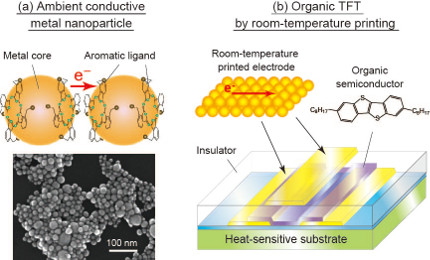Success in Forming Organic Thin-Film Transistors Through Room-Temperature Printing
Establishing Room-Temperature-Printed Electronics Without Raising the Temperature by Even 1°C
2014.05.08
(2014.06.16 Update)
National Institute for Materials Science (NIMS)
National University Corporation Okayama University
Colloidal Ink Co., Ltd.
New Energy and Industrial Technology Development Organization (NEDO)
A research team led by Dr. Takeo Minari, MANA Independent Scientist of the International Center for Materials Nanoarchitectonics (MANA) of NIMS, and Dr. Masayuki Kanehara, Assistant Professor at the Research Core for Interdisciplinary Sciences of National University Corporation Okayama University (Okayama University) and President of Colloidal Ink Co., Ltd., succeeded in establishing a process to form organic thin-film transistors (TFTs), conducting the entire printing process at room temperature under ambient atmospheric conditions, with the support of the Grant for Industrial Technology Research (Financial Support for Young Researchers) of the New Energy and Industrial Technology Development Organization (NEDO). The team also achieved an average mobility of 7.9 cm2 V-1 s-1 with an organic TFT formed on a flexible substrate by a room-temperature printing process.
Abstract
- A research team led by Dr. Takeo Minari, MANA Independent Scientist of the International Center for Materials Nanoarchitectonics (MANA; Director General: Masakazu Aono) of NIMS (President: Sukekatsu Ushioda), and Dr. Masayuki Kanehara, Assistant Professor at the Research Core for Interdisciplinary Sciences of Okayama University and President of Colloidal Ink Co., Ltd., received the support of NEDO's Grant for Industrial Technology Research (Financial Support for Young Researchers), and succeeded in establishing a process to form organic thin-film transistors (TFTs), conducting the entire printing process at room temperature under ambient atmospheric conditions. The team also achieved an average mobility of 7.9 cm2 V-1 s-1 with an organic TFT formed on a flexible substrate by a room-temperature printing process.
- Printed electronics, the field in which electronic devices are produced by printing functional materials in ink form and does not require large and expensive manufacturing equipment, has been drawing attention in recent years as a new technology for low-cost, large-area fabrication of semiconductor devices. By using plastic and other flexible substrates, the technology is expected to open paths for the mass production of devices by roll-to-roll processing or for new applications such as wearable devices. However, conventional printed electronics had a drawback of employing many high-temperature processes at 100 to 200°C. Because plastic substrates such as PET film generally have low heat resistance, there had been calls for the development of a low-temperature printing process which involves no high-temperature processes and which is applicable to a wide range of materials. However, such process had not been realized to date.
- In this research, the team established "room-temperature-printed electronics" by which electronics devices can be manufactured by conducting all of the printing processes at room temperature under ambient atmospheric conditions, without raising the temperature by even 1°C. Conventional printed electronics have mainly required high-temperature processes in order to sinter metal nanoparticle ink to be used as electrodes. Since conventional metal nanoparticles have used insulating materials as ligands for dispersing the nanoparticles in the ink, the nanoparticles have needed to be sintered in order to obtain a conductive metal film. In this research, the team succeeded in forming a metal film without post-coating sintering, by using conductive aromatic molecules as ligands of metal nanoparticles. The thin film obtained has achieved a resistivity of 9 × 10-6 Ω cm. In addition, by forming microscopic hydrophilic/hydrophobic patterns on the surface, the team patterned ambient conductive metal nanoparticles and organic semiconductors by a room-temperature process, and made organic thin-film transistors by forming all of the source and drain electrodes, organic semiconductors and gate electrodes by room-temperature printing. Organic TFTs formed on a plastic substrate and a paper substrate respectively indicated an average mobility of 7.9 and 2.5 cm2V-1 s-1. This value far exceeds the average mobility of amorphous silicon TFTs at 0.5 cm2 V-1s-1 and almost matches the mobility of mass-produced IGZO TFTs (up to 10 cm2 V-1 s-1).
- When manufacturing displays, etc. by printed electronics, circuits need to be printed on flexible substrates at a positional accuracy greater than several microns. Flexible plastic and paper substrates, which are weak against heat, became deformed or distorted under the conventional processing temperatures, leading to compromised accuracy. By conducting all of the manufacturing processes at room temperature, it will be possible to completely control the heat deformation of substrates and to print micro circuits at high accuracy. Furthermore, the production processes at room temperature under ambient atmospheric conditions would, in principle, enable the production of electronic devices on the surface of materials that are extremely weak against environmental changes, such as biomaterials. This achievement is expected to lead to application in diverse fields including medical care and bioelectronics.
- The research results will be published in Advanced Functional Materials in the near future.

Figure 1: Ambient conductive metal nanoparticles and an organic transistor created in this research
(a) Schematic and a scanning electron micrograph of ambient conductive metal nanoparticles. By using conductive aromatic ligands, the nanoparticles exhibit conductivity matching that of metal by room-temperature drying.
(b) Schematic of an organic TFT formed by a room-temperature printing process. Since all layers of the TFT can be formed without raising the temperature by even 1°C, non-heat-resistant materials can also be used as substrates. It also exhibits extremely high mobility compared to conventional organic TFTs.